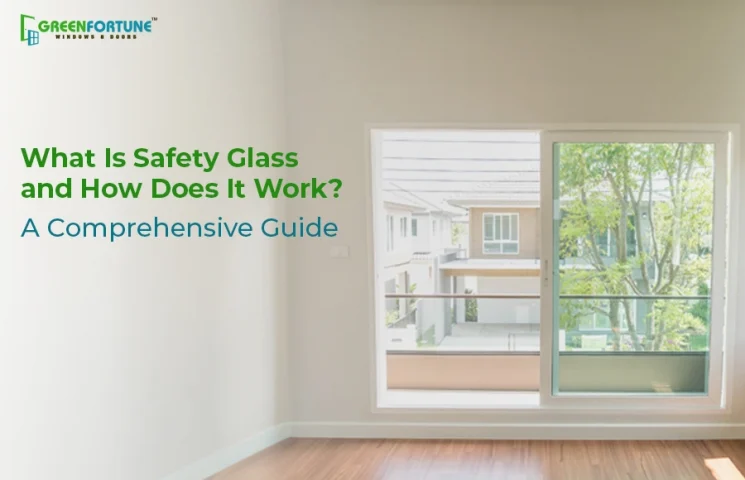
How uPVC Combination Windows Can Help You Economise on Energy Bills?
October 15, 2024
How to Get Rid of Ants in House: A Comprehensive Guide
October 16, 2024The use of safety glass windows dates back over a hundred years. It all began when individuals were in search of a way to make glass that would not result in dangerous pieces. In 1903, Édouard Bénédictus, a French chemist, who dropped a flask coated with plastic and it did not break up into pieces, by accident discovered one of the very first kinds of laminated glass window.
Over the years, many inventors have perfected improvements to safety glass that have made it more reliable and widely used.
Types of Safety Glass
Tempered Glass
Tempered glass is manufactured by heating regular glass to about 620 degrees Celsius and then cooling quickly. The surface of the glass becomes much stronger than regular glass through this process, called tempering.
When tempered glass breaks, it shatters into many small pieces that are blunt and unlikely to be cut as regular glass would.
Common uses include car windows, shower doors, glass doors, or even the partitions in an office because they are strong but safe.
Laminated Glass
Laminated glass is developed by placing a layer of plastic, normally polyvinyl butyral (PVB), between two pieces of glass. The glass and plastic layers bond at high temperatures and under pressure.
The plastic layer holds pieces together in case of breakage; thus, pieces do not fall through, and neither do other things pass through.
This type of glass is used in windshields, skylights, storefronts, and even in hurricane-resistant windows.
Wired Glass
Wired glass is made by embedding a wire mesh in molten glass during its processing. The wire mesh is laid out in the desired pattern before the molten glass is poured over it.
This wire mesh holds the glass upon its breakage, thus offering extra safety and giving resistance to fire. It is not as strong as tempered or laminated glass, but it has its own benefits. Typical uses include fire-rated doors and windows, schools, and industrial buildings.
Bulletproof Glass
The process involves laying many sheets of glass and plastic, normally polycarbonate. All these are then bonded together to form a thick, strong material able to stop bullets.
This is a very strong material, capable of stopping ammunition and the rest of high-velocity projectiles. The layers absorb the energy of the impact, which prevents penetration.
It is used in banks, military carrier vehicles, armored cars, and high-security building glass, including government buildings.
Other specialty safety glasses
There are other types of safety glass made for specific purposes. For instance, UV-blocking glass which helps protect against harmful ultraviolet rays. Other safety glasses are made to withstand very high or low temperatures and hostile environments.
How Safety Glass Works
Toughened glass windows are far more resistant than regular glass. It takes in and spreads out the force from impacts, which gives it extra resistance to breakage. If it does break, safety glass will break in ways designed to reduce the risk of injury. For example, tempered glass will shatter into small, blunt pieces, while laminated glass remains intact due to the plastic layer that binds it together.
The Advantages of Safety Glass
- Safety glass is way safer compared to regular glass since it does not break into sharp pieces. This reduces the risk of injury from broken glass.
- It is stronger and more hardened, so it's used in many applications where regular glass would easily break.
- Some of the safety glasses also insulate buildings, reducing their energy costs, and blocking out the most harmful UV rays of the sun from interiors, thus acting against sun damage.
- Certain strengthened glass types can eliminate most of the external noise, providing extra quietness within buildings and more comfort to the building users.
Safety Glass Applications
Automotive Sector
It is used for windshields, side, and rear windows for protection in case of an accident. Laminated glass is used in the windshield for its interlocking characteristic when it breaks, and tempered glass for the side and rear windows due to the strength it produces.
Construction and Architecture
Used for building facades, skylights, and partitions to provide safety and durability. Laminated glass is often used where hurricanes or earthquakes can prevail, while tempered glass is used for strength and safety in places with high traffic.
Public Transport
Used in bus windows, train windows, airplane windows, and partitions, this kind of glass ensures that passengers are safe during an accident and reduces potential harm from broken glass.
Household and interior design
Used in shower doors, tabletops, and cabinetry for safety and style. Tempered glass is common in shower doors due to its strength and differentiating characteristic of shattering into small, safe pieces, while laminated glass is used in tabletops to prevent sharp shards.
Security glass windows for home
It finds applications in bank security, military vehicles, and armored installations against attack. In such contexts, bulletproof glass is required to stop bullets and other different-caliber projectiles to protect people and property.
Safety Standards and Regulations
The various types of safety glass properties meet certain standards to be safe for use. These are laid down by various bodies, such as the American National Standards Institute, ASTM, and the European Standards. Glass manufacturers have their products certified in order to pass these safety standards.
Maintenance and care proper cleaning techniques
Clean the safety glass using a soft cloth and mild soap. Avoid all harsh chemicals that damage the surface and distinctly reduce its effectiveness.
- Due care needs to be exercised while handling safety glass to prevent scratching and chipping. Installation and maintenance shall also be in accordance with the manufacturer's instructions.
- Inspection and replacement schedule: The safety glass shall be intermittently inspected for any damage—either cracks or chips—and changed if necessary.
- Such frequent maintenance is done to ensure the continuation of the glass's expected level of safety and performance. The Future of Safety Glass The technology of safety glass is evolving.
- Innovations have been forthcoming to strengthen the technology and its applicability.
Conclusion
Safety glass is one of the chief constituents of today's world. Much stronger and therefore considerably safer, it has numerous uses that make it excel. Whether used in your car, home, or office, safety glass helps protect you and the people around you.
Discover GreenFortune, Your Partner in Quality uPVC Windows and Doors
At GreenFortune, we are proud to offer high-quality uPVC windows and doors at affordable prices. We offer and install a variety of window types for all homes with both durability and aesthetics in mind.
Contact us to find out more about the uPVC window design that we offer. Whether you are renovating your existing home or building a new one, partner with us to elevate the comfort levels and energy efficiency in addition to the style quotient of your space provided by our superior-quality uPVC windows.
Frequently Asked Questions
- What is the difference between safety glass and regular glass?
Safety glass is designed and manufactured to meet a much higher safety standard compared to regular glass. It withstands impacts, and on breaking, it shatters into many small, less dangerous pieces or stays together. This reduces the risk of injury. The regular glass, when broken, results in sharp and dangerous shards.
- Where is safety glass used?
Safety glass finds broad applications in automobiles (windshields, side, and rear windows), building façades (facades, skylights, interior partitions), public transport (windows, partitions in buses, trains, and airplanes), households (shower doors, tabletops, cabinet doors), and security settings such as bank windows and military vehicles alongside armored installations.
- What are the correct care and safety maintenance procedures for safety glass?
Clean safety glass with a soft cloth and mild soap only. It is low maintenance, but handling must not prompt scratching or chipping; installation and mounting are per the directions of the manufacturer. Inspect regularly for chips or cracks—replace glass if damage is evident for continued safety and protection.

